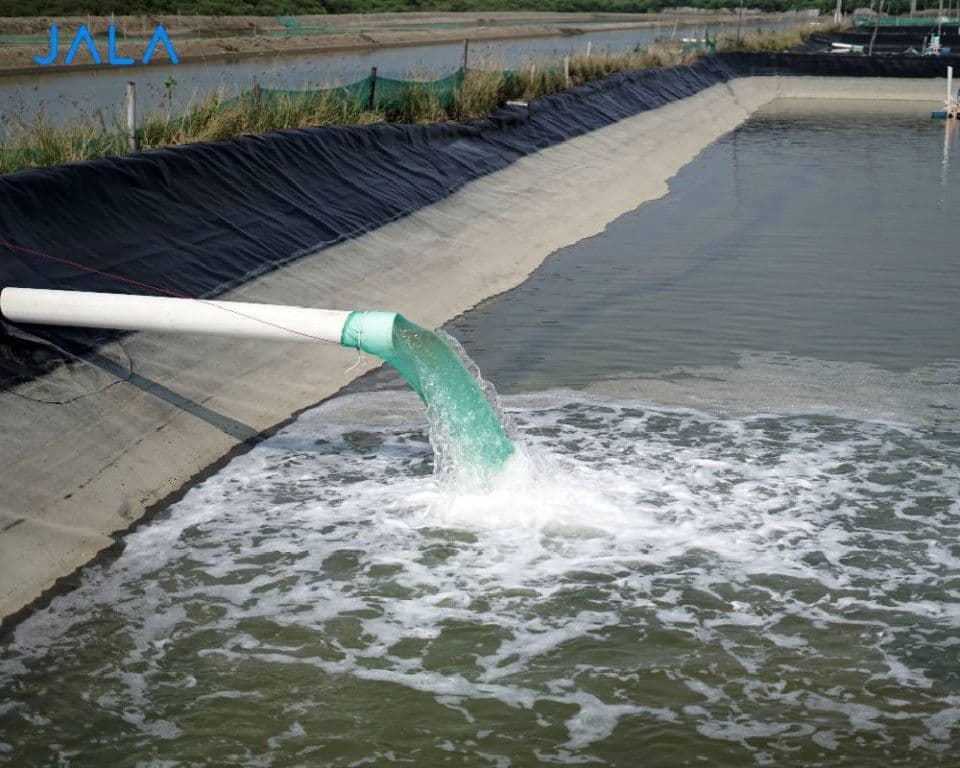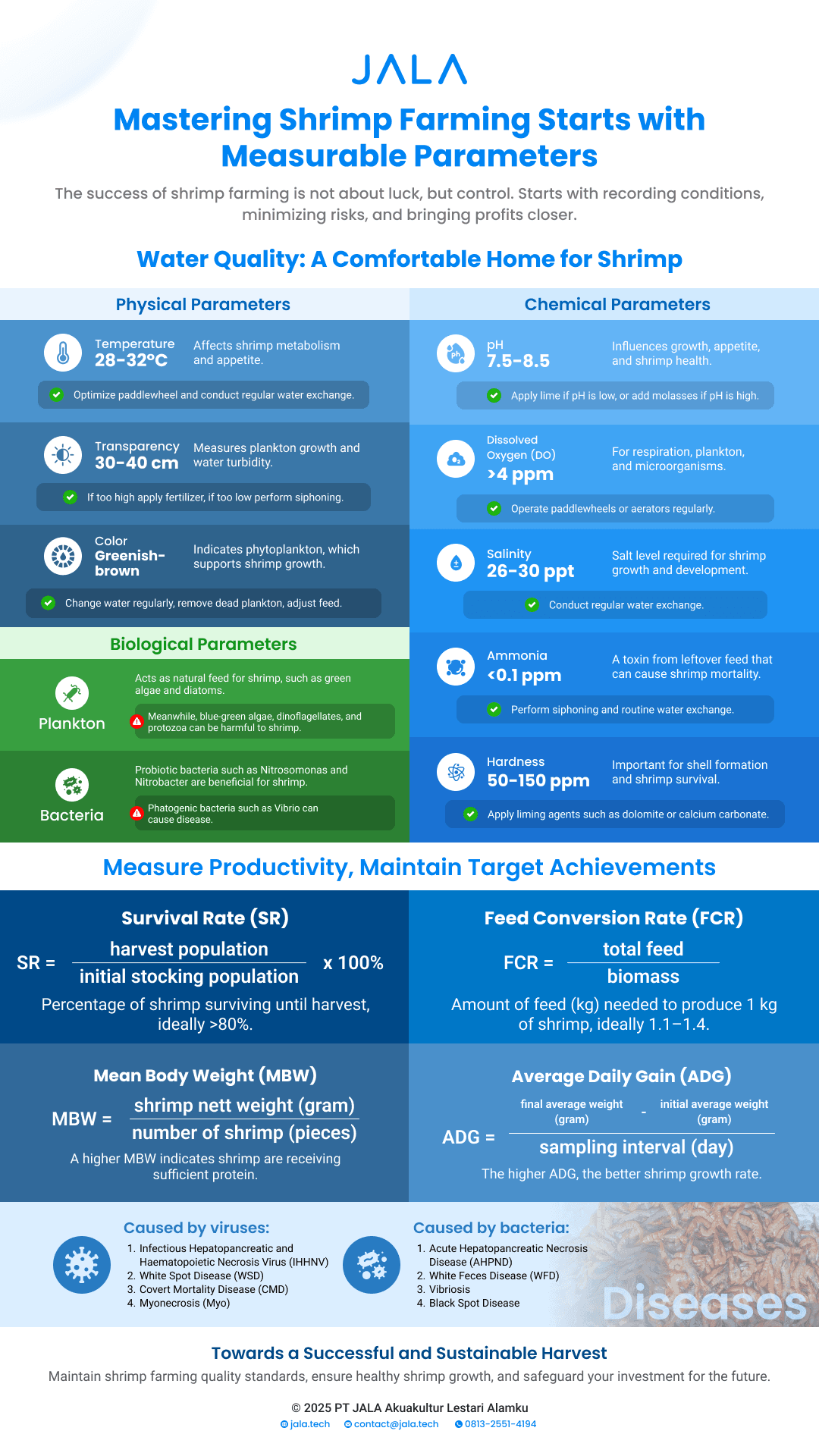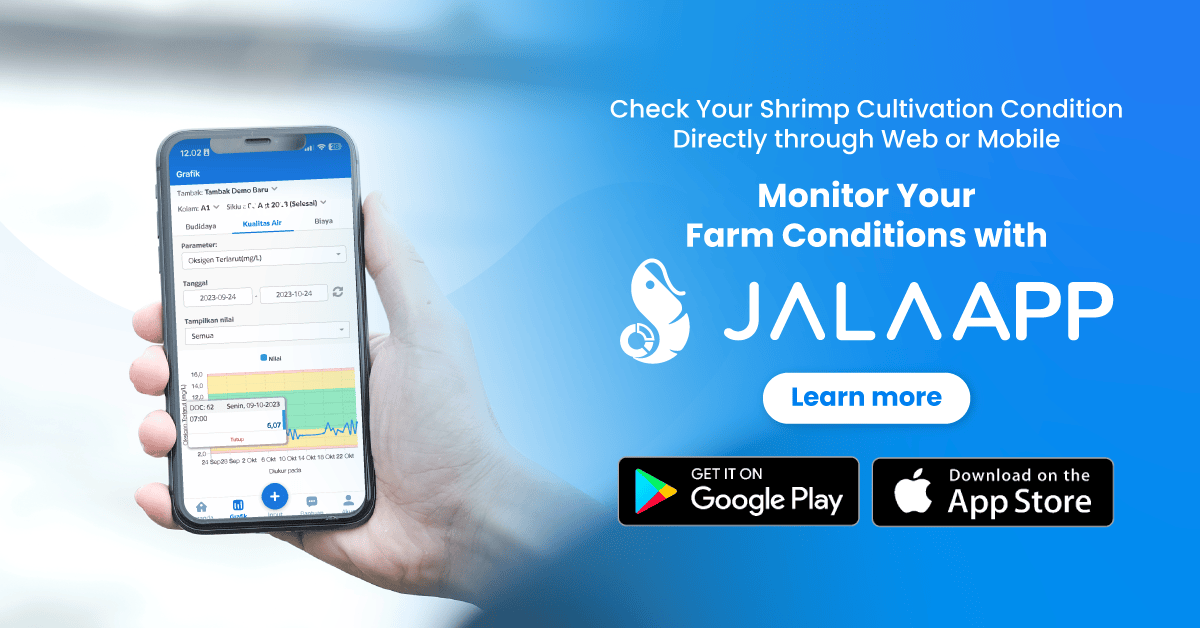
One of the most important factors to consider in shrimp farming is water quality. Shrimp ponds can utilize water from two sources: seawater and groundwater from wells. The quality of water, especially the source water that will be treated in tanks during preparation or throughout the cultivation period, needs to be ensured to support the growth and survival of shrimp. Some commonly used water quality parameters to assess the suitability of the water source for cultivation include temperature, salinity, pH, dissolved oxygen (DO), turbidity, nitrate, and phosphate content.
The quality of the water source can be assessed through three types of parameters, namely physical, chemical, and biological parameters as follows:
Physical Parameters
Temperature
The body temperature of shrimp follows the ambient temperature, so the temperature of the water source should not be too low or too high. If the water temperature is too low, the metabolic process will be hindered, decreasing the shrimp’s appetite. However, if the temperature is too high, the metabolism rate will be too high and can result in stress and mortality. The optimal temperature for cultivation is 28-30˚C.
Turbidity
Turbidity indicates how far sunlight can penetrate into the water. Sunlight is crucial for phytoplankton to photosynthesize and is influenced by the amount of plankton and suspended particles. The recommended turbidity level should be around 20-40 cm.
Color
Watercolor differs according to the number of phytoplanktons. The recommended color of the source water is green, as it supports shrimp growth better.
Chemical Parameters
pH
pH or the potential of hydrogen reflects the acidity or alkalinity of the source water. Many factors influence pH, such as the soil, and rain, as well as biological activities such as respiration and photosynthesis of phytoplanktons. To maintain shrimp metabolism and physiology, it is best to maintain a pH of 7.8-8.5.
Dissolved oxygen (DO)
Dissolved oxygen or DO is required for the respiration of shrimp and other organisms, including microorganisms that decompose organic matter in the pond. The recommended DO level in the water is ≥ 4 ppm.
Salinity
Salinity is the amount of salts dissolved in water. Salt is essential for shrimp growth. The recommended salinity for shrimp cultivation is 26-32 ppt.
Ammonia
Ammonia or NH3 may hinder shrimp growth and cause mortality. Excess ammonia content also produces an unpleasant smell from the water. The source water should have an ammonia content of ≤ 0.1 mg/L.
Hardness
Hardness reflects the concentration of Ca2+ dan Mg2+ ions in water. The recommended water hardness for shrimp cultivation is ≤ 300 ppm.
Biological Parameters
Plankton
Planktons are naturally occurring organisms in water which may also serve as shrimp feed. Phytoplanktons impact water DO and pH due to their photosynthetic activity during the day.
Bacteria
Harmful disease-causing bacteria, also called pathogens, may infect shrimp during cultivation. The most common species of bacteria to infect shrimp is the Vibrio spp., which needs to be eliminated through sterilization.

Source Water Quality Standard
The parameters for source water quality is regulated in the Minister of Marine Affairs and Fisheries Regulation No. 75/PERMEN-KP/2016 of 2016, which serves as a guideline for aquaculture farmers. The parameters to be regulated vary depending on the level of cultivation technology applied, namely extensive or traditional, semi-intensive, intensive, and super-intensive.
Dealing with Poor Source Water Quality
The quality of the water source can be determined through visual observations of physical parameters such as color and turbidity, as well as measurements for other parameters. Since the source water quality is affected by various uncontrollable natural factors, it is important for farmers to treat the water if its quality does not meet the standards. Sterilization, filtration, and treatments such as adding lime and probiotics can help improve water quality before and throughout the cultivation process, allowing the cultivation to achieve its desired productivity.
Record and Monitor Your Water Quality in JALA App
Recording and monitoring daily water quality during cultivation is as crucial. By regularly recording and monitoring, you can identify water conditions and determine the right treatment.
Therefore, JALA App is #HeretoHelp you to record, monitor, and understand your cultivation conditions conveniently! Sign up now at app.jala.tech or download the app at Google Play Store or App Store.

Resources:
Setyawan, Arief Rahmat, Setyawan Purnama, and Sudarmadji Sudarmadji. "Analisis Kesesuaian Air Sumber untuk Budidaya Udang di Kecamatan Purwodadi, Kabupaten Purworejo." Jurnal Perikanan Universitas Gadjah Mada 23.1 (2021): 25-30.





